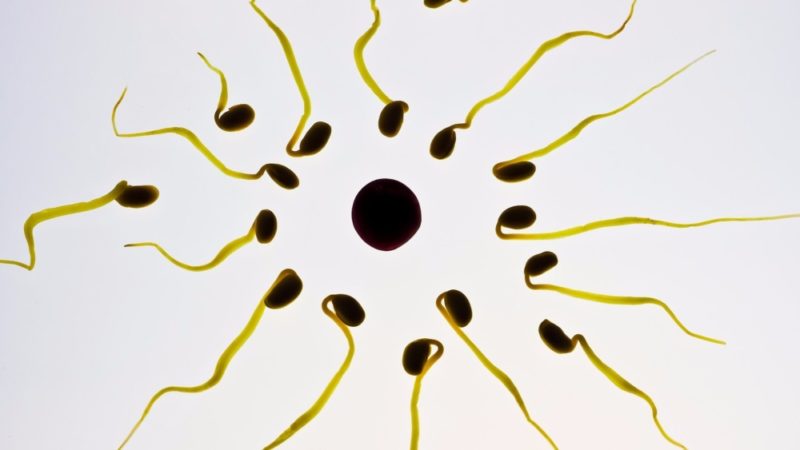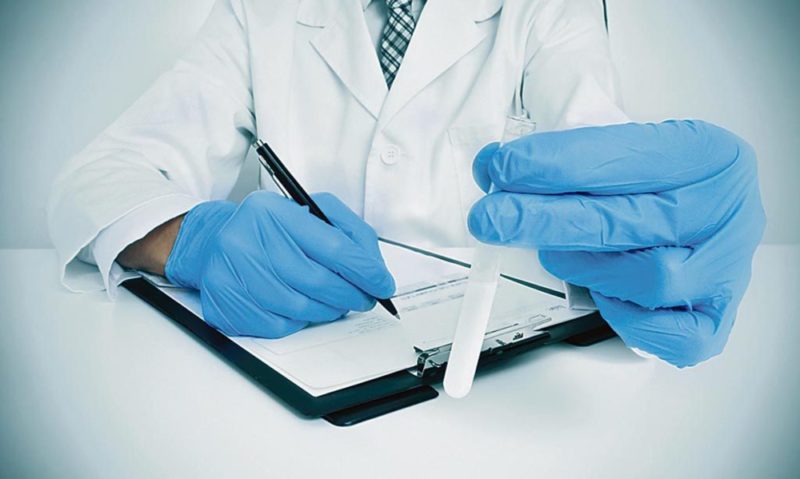Asthenozoospermia is a disease that few people know about. This ailment affects the male part of the population, but not every representative of the stronger sex knows what symptoms are associated with the pathology, and which specialist should be consulted at the first sign.
Material Content:
What is asthenozoospermia
Asthenozoospermia - what is it and how to treat it? This question is asked by at least 30% of the male population.
Asthenozoospermia is a disease that, according to the most recent information in the field of medicine, underlies nearly 50% of male infertility. This term means a decrease in the speed of movement of sperm in the seminal fluid (ejaculate).
Once in the vagina, the main task of the sperm is to fertilize the egg, and for this they must move very quickly to their goal, until the acidic environment of the vagina has destroyed them. So at this stage, if they move a little slower than expected, they will die, not even having passed half the way.
In a healthy man, the number of fast sperm should be at least 70%. Otherwise, the possibility of fertilization decreases sharply, that is, we can talk about a violation of the male reproductive system and the need for examinations.
The insidiousness of this disease lies in the fact that it does not have any symptoms, and a man may not even suggest its presence. However, when the time comes to conceive a child, he is faced with a problem.
Thus, the main characteristics of asthenozoospermia are:
- a decrease in sperm content of sperm that move in a straight path;
- general decrease in sperm velocity (less than 0, 025 mm / s.)
Reasons for the development of pathology
There are a lot of methods for treating asthenozoospermia. But in order to understand which one is to be used, it is initially necessary to establish the cause of the disease.
All these reasons can be conditionally divided into two large groups, depending on whether internal or external factors underlie the disease:
| Intrinsic factors | External factors |
|---|---|
| General weakening of the body's immunity | Frequent stress, fatigue |
| Autoimmune diseases | Direct heat exposure |
| Inflammation of the appendages | Alcohol and nicotine addiction |
| Sexually transmitted diseases | The consequences of surgery or varicose veins on the testicles (varicocele) |
| Viral infections | The effects of potent drugs on the body |
| Hormonal disorders | Prolonged sexual abstinence |
| Pathology of the prostatic secretion | Ecological situation in the place of residence, malnutrition |
| Genetics and heredity | General weakening of the body's immunity |
It should be noted that the age of the man is in no way associated with this disease.
Degree of violation
There are three degrees of development of asthenozoospermia, depending on the content of active sperm in the sperm.
- 1 degree. Minor asthenozoospermia. Active sperm count is less than 50%. If at the initial stage to identify the presence of this problem and conduct effective therapy, the disease does not constitute any harm;
- 2 degree. Moderate asthenozoospermia. Active sperm less than 40%. In this case, the man needs to undergo a full course of examination and establish the exact cause of this phenomenon until the disease begins to progress, and this must be done as soon as possible;
- 3 degree. Active sperm count is less than 30%. Treatment of the disease in this case will require prolonged therapy over an extended period of time.
Also, as a criterion for establishing the presence of this pathology, another gradation of sperm motility is distinguished:
- Category A includes fast spermatozoa with a rectilinear trajectory of movement;
- to category B - slow sperm with a rectilinear trajectory of movement;
- to category C - inactive spermatozoa moving in a chaotic order in one place;
- to category D - motionless sperm.
The presence of asthenozoospermia disease in men is determined by doctors according to the combination of these two factors (sperm motility and their activity).
- Sperm with a sperm content of groups A and B of less than 50% belongs to the first degree.
- To the second - sperm with sperm content of groups A and B less than 40%.
- The third group includes sperm with sperm content of groups A and B less than 30%, and the remaining amount is represented by spermatozoa of categories C and D.
Diagnostic Methods
Since this disease proceeds without any symptoms, it is possible to find out about its presence only through special procedures. The most common diagnostic method is spermogram delivery. After laboratory studies, it will become clear what the cause of the disease is, whether it is genetic or acquired.
If the nature of the pathology is due to genetics and hereditary factors, then treatment in this case will be meaningless. In this situation we are talking about infertility. If the reason lies in other factors, then long-term treatment and taking various drugs will help improve the situation and will contribute to recovery.
It is recommended to take a spermogram twice with an interval of 2 weeks so that the doctor can see the dynamics of the development of the disease and prescribe a more correct treatment.In addition, the doctor will conduct a full examination of the patient, information on past illnesses and injuries that could affect the problem under consideration will be entered on the outpatient card.
In addition to taking a spermogram, the doctor may prescribe one of the following studies or a combination of them:
- genetic research;
- prostate secretion test;
- analysis of patency of the vas deferens;
- Ultrasound and dopplerography of the scrotum;
- tests for the presence of infectious and inflammatory diseases.
After carrying out these manipulations and according to the results of the spermogram, the doctor will establish the presence or absence of pathology, the degree of asthenozoospermia, make a final diagnosis and prescribe a comprehensive treatment.
Treatment methods
All methods with which asthenozoospermia is treated can be divided into 2 broad groups: complex medical therapy and treatment with folk remedies.
Asthenozoospermia, the treatment of which is a set of measures for individual therapy, may be a thing of the past. However, the result depends on the correct prescription of therapeutic drugs, as well as on the reaction of the man's body to these drugs.
In addition, medical treatment may include:
- surgical intervention;
- prescribing a course of antibiotic and anti-inflammatory drugs (if the cause of the disease is infection that has entered the body);
- hormone therapy (used to improve the quality and quantity of sperm, if the cause of the disease is a reduced amount of male sex hormones);
- massaging the prostate and seminal vesicles.
Treatment with folk remedies can be considered as additional assistance to your body and always remember that although often folk methods are quite effective, any use should be, first of all, agreed with your doctor.
Alternative methods of treating asthenozoospermia include:
- ginseng tincture (affects the sexual activity of a man and activates it, has a beneficial effect on the entire male body as a whole);
- decoction from plantain (increases the level of male sex hormone - testosterone, increases sexual activity, as well as by diluting sperm, increases sperm activity);
- sage tea (favorably affects sperm quality).
Proper nutrition
There are several basic rules regarding food that must be observed in the presence of asthenozoospermia. In other words, there is a need to follow a diet and try to eat properly, since the recovery process also depends on this.
Here are the key points to keep in mind:
- remove all unhealthy foods from the diet;
- reduce the amount of animal fat consumed;
- limit yourself to eating fried, smoked and spicy;
- minimize or completely eliminate the use of alcoholic beverages and smoking.
At the same time, there is a list of useful products that, if possible, should be included in the diet of patients with asthenozoospermia:
- Foods rich in vitamin A content (Bulgarian red pepper, carrot, dried apricots, parsley, dill, sweet potatoes, dairy products, tomatoes, asparagus, strawberries).
- Products containing omega-3 fatty acids (all kinds of nuts, seafood, chicken).
- Products containing zinc (pork liver, beef liver, chicken eggs, oatmeal).
- Products in which folic acid is present (legumes, any vegetables green in color, apples).
In order to make sure that nutrition really affects the quality of semen, you must periodically take a spermogram, which will show the situation in dynamics.
Asthenozoospermia and pregnancy
Pregnancy with asthenozoospermia is possible. You must always remember that this disease is not a sentence or a cause of male infertility.With the right treatment, following all doctor's prescriptions, adjusting one's diet, and playing sports, the disease recedes in 90% of cases. Accordingly, a man can become a father, without experiencing any difficulties.
There are rare situations when the treatment is unsuccessful. Even in this case, don’t give up, a man can still become a father using modern medical technologies such as artificial insemination or in vitro fertilization (IVF).
Prevention
The complex of preventive measures of asthenozoospermia includes, first of all, the fight against factors that can cause this ailment.
The basic principles are as follows:
- remove toxic substances into the body to the maximum, including eliminating smoking and reducing the consumption of alcoholic beverages;
- try to comply with normal temperature conditions without overheating and cooling;
- lead a regular sex life;
- actively engage in sports;
- to exclude wearing underwear, which restricts movement in the groin area;
- comply with proper nutrition, sleep and rest;
- in case of detection of any infectious foci - compliance with all recommendations for therapy, in order to exclude the transition of the disease to the chronic stage.
In conclusion, we can say that asthenozoospermia is a very serious disease that can significantly affect male reproductive functions. However, if you strictly follow all the prescriptions of doctors, lead a correct lifestyle and do not let the situation go by itself, then in most cases the disease recedes, and a man can conceive a child and become a father in a natural way.

















